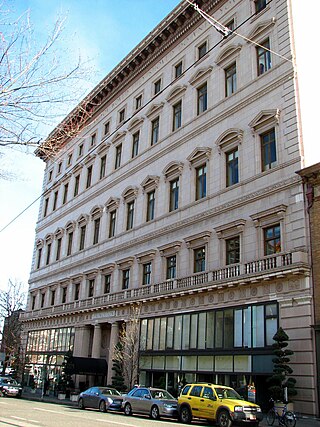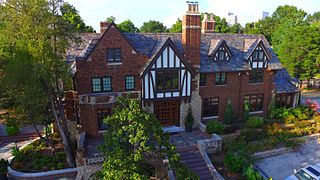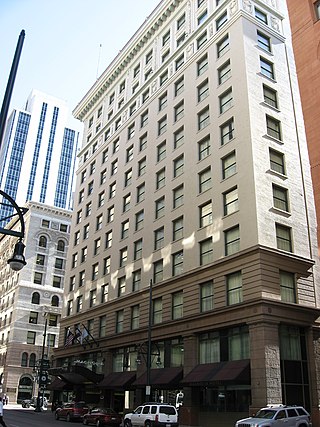
The Cimarron Hotel is a historic hotel located in Cimarron, a small town located in southwest Kansas, United States.

The Lawyers Building is an office building located at 137 Cadillac Square in downtown Detroit, Michigan. It was also known as the American Title Building. The building was listed on the National Register of Historic Places in 1982.

Hot Lake Hotel is a historic Colonial Revival hotel originally built in 1864 in Hot Lake, Union County, Oregon, United States. The hotel received its namesake from the thermal spring lakes on the property, and operated as a luxury resort and sanitorium during the turn of the century, advertising the medicinal attributes of the mineral water and drawing visitors worldwide. It is also the first known commercial building in the world to utilize geothermal energy as its primary heat source.

The Seward Hotel, also known as the Governor Hotel, is a historic hotel building in downtown Portland, Oregon, United States, that is listed on the National Register of Historic Places (NRHP). Built in 1909, it is one of two NRHP-listed buildings that make up the Sentinel Hotel, the other being the 1923-built Elks Temple. The Seward was renamed the Governor Hotel in 1931, closed in the mid-1980s, and reopened in 1992 joined with the former Elks building, and thereafter formed the east wing of a two-building hotel.

Munson Valley Historic District is the headquarters and main support area for Crater Lake National Park in southern Oregon. The National Park Service chose Munson Valley for the park headquarters because of its central location within the park. Because of the unique rustic architecture of the Munson Valley buildings and the surrounding park landscape, the area was listed as a historic district on the National Register of Historic Places (NRHP) in 1988. The district has eighteen contributing buildings, including the Crater Lake Superintendent's Residence which is a U.S. National Historic Landmark and separately listed on the NRHP. The district's NRHP listing was decreased in area in 1997.

Tifton Commercial Historic District, in Tifton in Tift County, Georgia, is a historic district that was listed on the National Register of Historic Places (NRHP) in 1986 and expanded in 1994. The original listing was portions of 10 blocks including buildings from the 1890s to the late 1930s, most built of brick.

The W New York Union Square is a 270-room, 21-story boutique hotel operated by W Hotels at the northeast corner of Park Avenue South and 17th Street, across from Union Square in Manhattan, New York. Originally known as the Germania Life Insurance Company Building, it was designed by Albert D'Oench and Joseph W. Yost and built in 1911 in the Beaux-Arts style.

The Prescott Elks Theater and Performing Arts Center is a classically designed turn of the 20th century opera house seating over 500. Completed in 1905 and listed on the National Register of Historic Places as Elks Building and Theater, it was one of many "Elks' Opera Houses" across the country. Now over a hundred years later only one still exists.

The Elks Lodge Building in Oklahoma City, Oklahoma, also known as the ONG Building, is significant as an architectural oddity, and for the association of its three successive owners in the history of the state. It is Italian Renaissance-style building that was built in 1926. It was listed on the National Register of Historic Places in 1980.

The Elks Temple, also known as the Princeton Building and as the west wing of the Sentinel Hotel, is a former Elks building and historic hotel building in downtown Portland, Oregon, United States. Built in 1923, it is one of two NRHP-listed buildings that make up the Sentinel Hotel, the other being the 1909-built Seward Hotel. The Seward was renamed the Governor Hotel in 1932, and in 1992 it was joined with the former Elks building, and thereafter the building became the west wing of a two-building hotel, an expanded Governor Hotel. The hotel's main entrance was moved to this building from the east building in 2004. The Governor Hotel was renamed the Sentinel Hotel in 2014. Use of the building as an Elks temple lasted less than a decade, ending in 1932.

The Ancient Order of Hibernians Hall, also known as Hibernian Hall, was a historic building in Anaconda, Montana, United States, that is listed on the National Register of Historic Places.

Montgomery Park is an office building and former Montgomery Ward mail-order catalog warehouse and department store located in Portland, Oregon, United States, built in 1920. It is listed on the National Register of Historic Places under its historic name Montgomery Ward & Company Building. The building is located on property once used for the Lewis and Clark Centennial Exposition, of 1905. It was occupied by Montgomery Ward from 1920 until 1985, although the majority of the company's operations at this location ended in 1982. The building is the second-largest office building in Portland with 577,339 square feet (53,636.5 m2).

Hotel Ottumwa, formerly known as the Parkview Plaza, is an historic building located in downtown Ottumwa, Iowa, United States. Built as a first-class hotel from 1916 to 1917, it is significant for the part it played in the city's social history and commercial development. By 1915, what had been Otuumwa's first-class hotel, the Ballingall Hotel, was in decline and a group of local businessmen met to plan for the new development. They organized a corporation to sell shares to the local citizens. A total of 309 people bought shares, with the average investment being $500. A further $150,000 was realized by selling bonds. A banquet was held on September 4, 1917, and a grand reception and ball was held two days later to celebrate the opening of the hotel. Over the years various businesses occupied the main floor storefronts. Bowling alleys were added in the basement in 1927. Radio station WIAS broadcast from the hotel from 1928, when it moved to Ottumwa from Burlington, Iowa, until 1934 when it went off the air. Major renovations were undertaken in 1939, 1951, and 1982. The building remains a hotel. It was listed on the National Register of Historic Places in 2012.

Frederick Carl Eberley was a prominent architect in Denver, Colorado. His work included the Barth Hotel (1882). He is also credited with Kopper's Hotel and Saloon, also known as the Airedale Building, added to the National Register of Historic Places in 1999. Eberley lived in the Schulz-Neef House, built in 1881 at 1739 E. 29th Avenue, for a time after German immigrant R. Ernst Schulz, a bookkeeper at the German National Bank and real estate investor for whom it was built. Eberley later lived at 29th Avenue and Gilpin Street. Eberley was a German immigrant and his commission for the Kopper's Hotel and Saloon came from a fellow German immigrant. His other work includes Colorado State Armory, Blatz Brewery, Colorado Bakery & Saloon, and Groussman Grocery.

The McBirney Mansion in Tulsa, Oklahoma was the home of James H. McBirney, co-founder of the Bank of Commerce in Tulsa in 1904. He was the original owner of the mansion, built by architect John Long in 1928, and lived there until 1976. The mansion contained 15,900 square feet (1,480 m2) and sits on a 2.91 acres (11,800 m2) lot. The mansion was bought by Donna and Roger Hardesty who lived there for 5 years. Eventually it was bought by a law firm that turned it into a law office. By 2007, was purchased by former American Airlines President George Warde, who had plans to transform it into a boutique hotel. In the meantime, the McBirney Mansion was used as an event center. Warde died in 2012, and events stopped being held at McBirney. By February 2012, the Pauls Corporation, a Denver real estate management company, acquired the mansion as part of the suit's settlement. Tulsa attorney, Gentner Drummond, bought the mansion from Pauls Corp. in 2014, announcing his intention to make it his family's home.

Benevolent and Protective Order of Elks, Lodge Number 878 is a historic Elks lodge on Queens Boulevard in the Elmhurst neighborhood of Queens in New York City. The 3+1⁄2-story Italian Renaissance-style main building and two-story annex were both built in 1923–1924 and designed by the Ballinger Company. A three-story rear addition was added in 1930.

The DeLong Agricultural Implements Warehouse, on Patterson St. in Lexington, Kentucky, was built in 1881. It was listed on the National Register of Historic Places in 1980.

The New York Hotel in Salt Lake City, Utah, at 42 Post Office Pl., was built in 1906. It was listed on the National Register of Historic Places in 1980.

The First National Bank Building, also known as the American National Bank of Denver, Colorado was originally built as the headquarters building in 1911. Located at the corner of 17th and Stout Streets, it is now the Magnolia Hotel. It was listed on the National Register of Historic Places in 1996. In 2000, it became part of the Downtown Denver Historic District.

The Amos H. Root Building, or simply the Root Building, at 1501-1529 Platte St. in Denver, Colorado, was built in 1884 for businessman Amos H. Root. It was listed on the National Register of Historic Places in 1980.






















